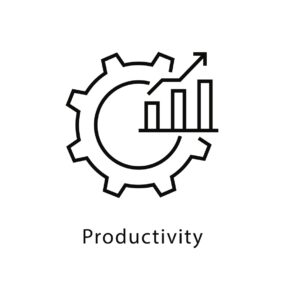Managing employees can be one of the most challenging—and also most rewarding—responsibilities as you move up within a company. When your management works and you see your employees surpass even their own expectations, it’s wildly exciting and incredibly fulfilling!

The great news? You don’t need a big budget to inspire your employees. The challenging part? Your management style can either motivate and inspire or lead to massive turnover as “employees join companies and leave managers.”
6 Questions to Ask Yourself to UP Your People Leadership Abilities!
Q1: What does your culture say about you as a leader?

A company’s culture is set by the tone at the top. Like a stone thrown in a pond, the messages your CEO and their direct reports espouse will ripple throughout the organization. It doesn’t stop there though as many managers double down on the messages, driving employees to look elsewhere. After all, the popular saying that “employees don’t leave companies, they leave managers” is more relevant now than ever.
What messages are you and other senior leaders conveying to your workforce?
Q2: Do you develop your people (or do their skills come to you and die)?
As former President John F. Kennedy once proclaimed “leadership and learning are indispensable to each other.” To build leaders from within (and be ready for the next decade), learning needs to never end. Employees are demanding it too! According to LinkedIn Learning: “94% of employees say that they would stay at a company longer if it invested in their career development.”
 You may have heard the term “learning environment” but what exactly does that mean?” It means making training and development opportunities accessible and easy, for both the managers and employees. It means building in time during the workday for employees to learn (better yet, make it a part of their daily responsibilities – to learn something new while teaching a junior member of the staff new skills!). It means building in a rewards system for employees who make teaching and learning a priority. It means creating formal leadership development plans for your employees (starting with those high potential employees who would be hard to replace). It means providing recognition and visibility to employees whose work you want others to emulate.
You may have heard the term “learning environment” but what exactly does that mean?” It means making training and development opportunities accessible and easy, for both the managers and employees. It means building in time during the workday for employees to learn (better yet, make it a part of their daily responsibilities – to learn something new while teaching a junior member of the staff new skills!). It means building in a rewards system for employees who make teaching and learning a priority. It means creating formal leadership development plans for your employees (starting with those high potential employees who would be hard to replace). It means providing recognition and visibility to employees whose work you want others to emulate.
What are you doing to develop your people and/or encourage (nay, require) your managers to develop their people?
Q3: How are you measuring productivity?
 A lot has certainly been written nowadays on employee productivity (particularly when it comes to discussions surrounding work-from-home planning). The challenge with this is that many managers don’t know how to measure productivity – instead opting for the notion that face-time is key. Rethinking goal-setting is a good start (as Tony Robbins said, “Setting goals is the first step in turning the invisible into the visible.”).
A lot has certainly been written nowadays on employee productivity (particularly when it comes to discussions surrounding work-from-home planning). The challenge with this is that many managers don’t know how to measure productivity – instead opting for the notion that face-time is key. Rethinking goal-setting is a good start (as Tony Robbins said, “Setting goals is the first step in turning the invisible into the visible.”).
Ask yourself, am I assigning tasks or goals? A goal is what you want to do or achieve (and is related to the “bigger picture” picture for the company or your department) while a task is the small step you make to move toward your goal. (Marsha, I pulled this from this site: https://www.habitsforwellbeing.com/what-is-the-difference-between-a-goal-and-a-task/). Set clear and concise goals (i.e., what does the “end” look like when this project is complete?), then step back and let your employees determine how to achieve those expectations. Use your knowledge and experience to set deadlines given the existing skill-base of your employees (chances are, since they are still learning, it will take them longer to accomplish goals while they think through and learn from doing the various tasks needed to complete the project). Include a discussion on how your employee will keep you updated on the progress so you can ensure they don’t go too far off the rails (and jeopardize deadlines). Discuss dates with your employees and get their buy-in (while discussing any challenges they anticipate and how they might overcome them).
A final check on if you’re merely assigning tasks (vs. goals)? There needs to be at least one decision-point in a goal – a chance where they could make the wrong choice. It’s in the active learning from mistakes that learning begins. Think back to your own growth – did you learn more from being told something or from trying it yourself and learning how not to do things in the future?
Are you merely assigning tasks for your employees to complete or are you assigning goals designed to challenge and develop your employees’ skill sets?
Q4: Is there anything interesting about the work that your employees do on a day-to-day basis?
Management theorist Frederick Herzberg made a compelling statement when he said “If you want someone to do a good job, give them a good job to do.” What does that mean? Employees should have at least part of their job be of interest to them.
 Now, does that mean if my employee wants to be the CEO, I should try to accommodate? Possibly. With 25 years in senior level positions within organizations, running across an employee who wanted to lead the company was not unusual. However, instead of laughing at their request (or thinking “who do they think they are?!?!”) discuss how you can help them become a CEO of their own company. Having experienced this myself at Oxygen Media, I would share that the succession path is set here as there are 24 people in line to become CEO (including myself!) but if they hung with me, I’ll teach them skills they can use in the top spot (oh, and also please hire me when you obtain that new position! 😊).
Now, does that mean if my employee wants to be the CEO, I should try to accommodate? Possibly. With 25 years in senior level positions within organizations, running across an employee who wanted to lead the company was not unusual. However, instead of laughing at their request (or thinking “who do they think they are?!?!”) discuss how you can help them become a CEO of their own company. Having experienced this myself at Oxygen Media, I would share that the succession path is set here as there are 24 people in line to become CEO (including myself!) but if they hung with me, I’ll teach them skills they can use in the top spot (oh, and also please hire me when you obtain that new position! 😊).
Talk to your employees and ask them what they want to do in life. What are their goals and why? Even with jobs that are inherently boring (and don’t all jobs have something boring about them?!?), I can provide employees with at least one stimulating task or project that taps into their future goals. And by doing that, I’m helping them realize their goal which in turn helps keep them around longer.
What are your employees’ hopes and dreams and how can you tie their day-to-day into helping to achieve those goals?
Q5: Are your employees cogs in a wheel or are they part of the bigger picture?
Think about it…what if every employee in your organization understood the Big Picture driving your organization and their role in the plan for achieving success? Do you think that could have an impact on the success of the organization? The chances are good that it will be helpful. (Heck, even employees who are only looking for a paycheck care about the success of the company long-term so that the cash keeps coming in!).
The challenge we have though as senior leaders is we decide we don’t have the time to involve our employees or they won’t be able to understand the Bigger Picture. So instead of involving them in the success of the organization, we reduce our employees to cogs in a wheel. We put our employees on auto-pilot and have them do the same job day in and day out.
 As people leaders, the organization would be better served if we gave our employees a seat at the able. If we involved them in decisions that impacted them. If we let them see how they are contributing to the Big Picture. To do that, to grow our employees (and have a shot at retaining them), we need to expose our employees understand all aspects of the company – not just their department or role.
As people leaders, the organization would be better served if we gave our employees a seat at the able. If we involved them in decisions that impacted them. If we let them see how they are contributing to the Big Picture. To do that, to grow our employees (and have a shot at retaining them), we need to expose our employees understand all aspects of the company – not just their department or role.
In the article entitled Help Your Employees Find Purpose or Watch Them Leave, following the pandemic, nearly two-thirds of US-based employees were re-thinking their purpose on life. According to that same article, “people who live their purpose at work are more productive than who people don’t.” All companies add value to the world (after all, people are buying your product). How much time do you spend connecting what the individual employee does on a daily basis to how they are helping the world and others? By making that connection more overt, by connecting your product to what helps to power the world, the more an employee can feel good about their contribution to society.
Do you employees understand the value they bring to the organization and how what they do helps to power the world?
Q6: Can you give meaningful feedback that inspires change (or does it inspire your employees to update their LinkedIn profile)?
You can have the greatest CEO/executive leadership in all the world, but if you have terrible middle managers, it will be hard to have an organization that succeeds in the long-run (after all, it’s the middle managers that influence the most employees). It used to be that companies could get away with promoting great individual contributors without training them. Some succeeded, but many were left floundering to get work accomplished through others.

Unfortunately, that has caught up with many companies and they are now paying the price as great employees leave (writing horrible company reviews on Glass Door, thus taking down other potential hires with them).
Although simplistic, managers have to be able to give constructive feedback in a way that leaves their employee grateful for having been given the message. Actually, let me take a step back…managers need to give feedback to begin with. The stats speak for themselves:
- 65% of employees desire more feedback.
- Companies that invest in regular employee feedback have 14.9% lower turnover rates than organizations where employees do not receive feedback.
- Four out of ten employees who receive little to no feedback are actively disengaged from their work.
- 69% of employees say they would work harder if they felt their efforts were being recognized through feedback.
- 43% of highly engaged employees receive feedback at least once a week.
Giving difficult feedback is tough. Even if you’ve given difficult feedback hundreds of times, it’s still tough each and every time. As Robert Allen a leading expert on business, finance and motivation, put it “There is no failure. Only feedback.” There is failure if you don’t provide feedback. Train your managers that feedback is a requirement of the job and that if they cannot do it, they need to relinquish their post.
Summary
As people leaders, it’s our job to unleash the potential in our employees (even if they don’t see it in themselves). As business leaders, as our products and services continue to evolve, it’s critical that we start now to develop our employees to meet the future needs of our organizations.
What are you doing to ensure your leadership meets the changing needs of your workforce?
P.S. If you’re looking for a deeper dive into leveling up your people leadership abilities, check out my private program: Elevate Your People Management – Fueling the Bottom Line. The next cohort starts on March 19th!
